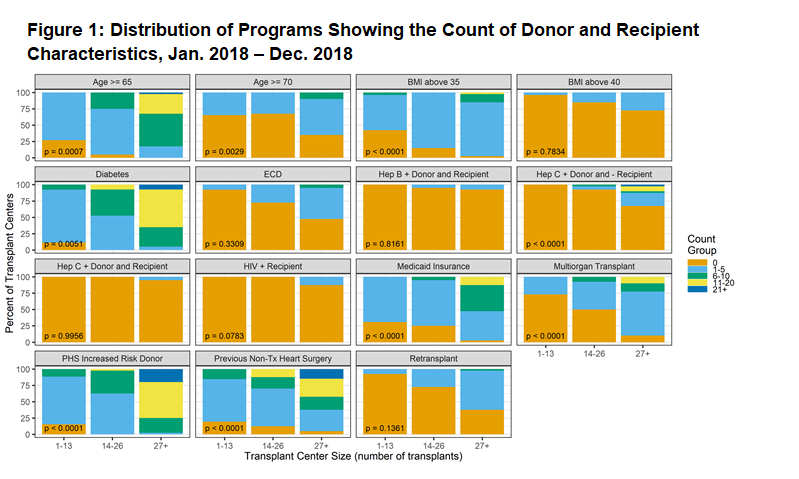Variations in Recipient and Donor Clinical Characteristics between Heart Transplant Centers
1Nephrology, Hennepin Healthcare Research Institute, Minneapolis, MN, 2College of Design, University of Minnesota, Minneapolis, MN, 3Hennepin Healthcare Research Institute, Minneapolis, MN, 4Cardiology Division, University of Minnesota Department of Medicine, Minneapolis, MN, 5Department of Medicine, Hennepin Healthcare, Minneapolis, MN
Meeting: 2020 American Transplant Congress
Abstract number: 486
Keywords: Heart, Heart transplant patients, Waiting lists
Session Information
Session Name: All Organs: Disparities to Outcome and Access to Healthcare II
Session Type: Oral Abstract Session
Date: Saturday, May 30, 2020
Session Time: 3:15pm-4:45pm
 Presentation Time: 3:39pm-3:51pm
Presentation Time: 3:39pm-3:51pm
Location: Virtual
*Purpose: When a patient has discretion over which heart transplant program will evaluate them for the waitlist, prior knowledge of program acceptance practices can enable patients to select a program that maximizes access to transplantation and improves outcomes.
*Methods: We analyzed recent heart recipient and donor data from the Scientific Registry of Transplant Recipients (SRTR) to determine how characteristics (e.g. age, insurance type, BMI) vary between transplant programs. SRTR data included recipients (n=5,569) and donors at each adult program between Jan. 1, 2016 and Dec. 31, 2017. The distribution of recipient and donor characteristics was plotted and grouped into small (1-13 transplants/year), medium (14-26 transplants/year), and large (27+ transplants/year) sized centers. Frequency of recipients ranges from 0 to greater than 21. P-values were calculated: chi-squared tests for the proportion of recipients (or donors) with the listed characteristics by transplant program.
*Results: In the US, recipient and donor characteristics vary across programs. Select recipient factors (e.g. BMI>40 and Retransplant) and donor characteristics (e.g. ECD) are limited, even among the largest programs. Similarly, counts of combined donor and recipient factors suggest that even the largest programs rarely, if ever, transplant HCV+ donor organs into HCV+ recipients, while larger centers are more likely to allocate HCV+ donor organs to HCV- recipients. At the same time, recipient characteristics like Medicaid insurance, Diabetes, and Age greater than 65, do not appear to be prohibitive of transplant and are observed across differently sized programs.
*Conclusions: Heart transplant recipient and donor characteristics vary across programs. Data describing recipient characteristics may be useful if provided to candidates and can guide them to select a program with recent experience transplanting patients like themselves.
To cite this abstract in AMA style:
McKinney WT, Bruin MJ, Chu S, Schladt D, Synder J, Martin CM, Alexy T, Kasiske BL, Israni AK. Variations in Recipient and Donor Clinical Characteristics between Heart Transplant Centers [abstract]. Am J Transplant. 2020; 20 (suppl 3). https://atcmeetingabstracts.com/abstract/variations-in-recipient-and-donor-clinical-characteristics-between-heart-transplant-centers/. Accessed January 2, 2026.« Back to 2020 American Transplant Congress

